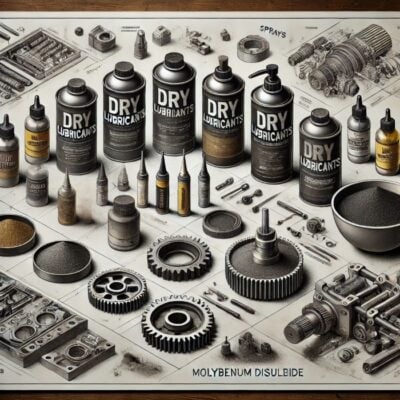Know About Different Types Of Dry Lubricants
When the moving or rolling or sliding parts in machines rub against each other a resistance is encountered to their movement. This resistance is called friction and it can cause wear and tear of the surfaces of the moving parts. Therefore a substance has to be introduced between the two surfaces to reduce friction. This substance is known as a lubricant.
Lubricants are used to keep the moving or rolling or sliding parts apart to reduce friction and damage to the moving parts. There are different types of lubricants such as solid/dry lubricants, liquid lubricants, semi-solid lubricants and gaseous lubricants.
Function of lubricants
- The main purpose of using the lubricants is to allow smooth operation of the moving parts and enhance the favourable characteristics like low friction, reduced wear and low noise.
- Lubricants help to reduce the friction and wear by forming a lubrication film on the surface of the moving parts and prevents contact between the surfaces.
Dry lubricants
A dry lubricant is used as powder or thin film to provide protection to the moving parts. Dry lubricants are used in dry conditions and in applications where liquid lubricants are unsuitable. Dry lubricants provide a low and constant friction between the two moving parts.
Dry lubricants are chemically inert and can be used in chemically reactive conditions.. Dry lubricants can be used in powder form or with binders to make them stick to the moving surfaces. The lubricant can adhere strongly to the moving parts and are not lost rapidly.
Dry lubricants have low volatility and can be used in high vacuum applications. They do have a tendency to contaminate the environment or the products are therefore used in food and textile industries. They stay stable over a wide temperature range and have good load carrying capacity.
Some of the dry lubricants are Tungsten Disulfide (WS2), Hexagonal Boron Nitride (hBN), Molybdenum Disulfide, Polytetrafluoroethylene (PTFE) and Graphite (C). These dry lubricants are non-toxic and do not harm the environment. They help to reduce friction and wear between the moving parts and enhance the performance of the machines.
Structure of dry lubricants
The WS2, hBN, MoS2 and Graphite lubricants have a layered-lattice structure. The materials can easily shear parallel to the layers than across them. They can support relatively high loads at right angles to the layers. When a shear force is applied the layers easily glide past one another which leads to a low coefficient of friction.
WS2 has an hexagonal layered structure with a layer of Tungsten atoms sandwiched between two layers of Sulphur atoms. Within the layer the W atoms are strongly bonded to the S atoms. The layers are connected together by weak Van der Waals forces.
hBN has a layered structure with Boron and Nitrogen atoms arranged in a hexagonal lattice. Within each layer the Boron and the Nitrogen are strongly bonded with covalent bonds and the layers are connected by weak Van der Waals forces.
MoS2 has a hexagonal crystal structure with a layer of Molybdenum atoms sandwiched between two layers of Sulphur atoms. There are strong covalent bonds between the atoms of a layer and the layers are connected together by weak Van der Waals forces.
Graphite has a layered structure consisting of Carbon atoms. Each layer consists of a ring of 6 Carbon atoms which are bonded with strong covalent bonds. The layers are connected together by weak Van der Waals forces.
Polytetrafluoroethylene (PTFE) is a fluorocarbon solid and consists of Carbon and Fluorine atoms. The chain of Carbon atoms is surrounded by the Fluorine atoms on either side. The Carbon Fluorine bond is strong and makes PTFE non-reactive. It can be used as a dry lubricant.
Lubrication mechanism
Dry lubricants are used in thin film lubrication and extreme pressure lubrication as follows:
Thin film lubrication
Thin film lubrication is preferred where a lubricant film cannot persist. Therefore dry lubricant powders are used to lubricate the clearance space between the moving parts. The lubricant can get adsorbed on the moving parts by using physical or chemical forces. This adsorbed film helps to keep the moving parts away from each other and reduce friction.
Extreme pressure lubrication
In this type of lubrication dry lubricants are used as additives in mineral oils to form a more durable film on the moving parts. In this type of lubrication the moving parts are at high temperature, high pressure or high speed which can lead to a high local temperature. Liquid lubricant will fail to stick to the moving parts and may even vaporise.







